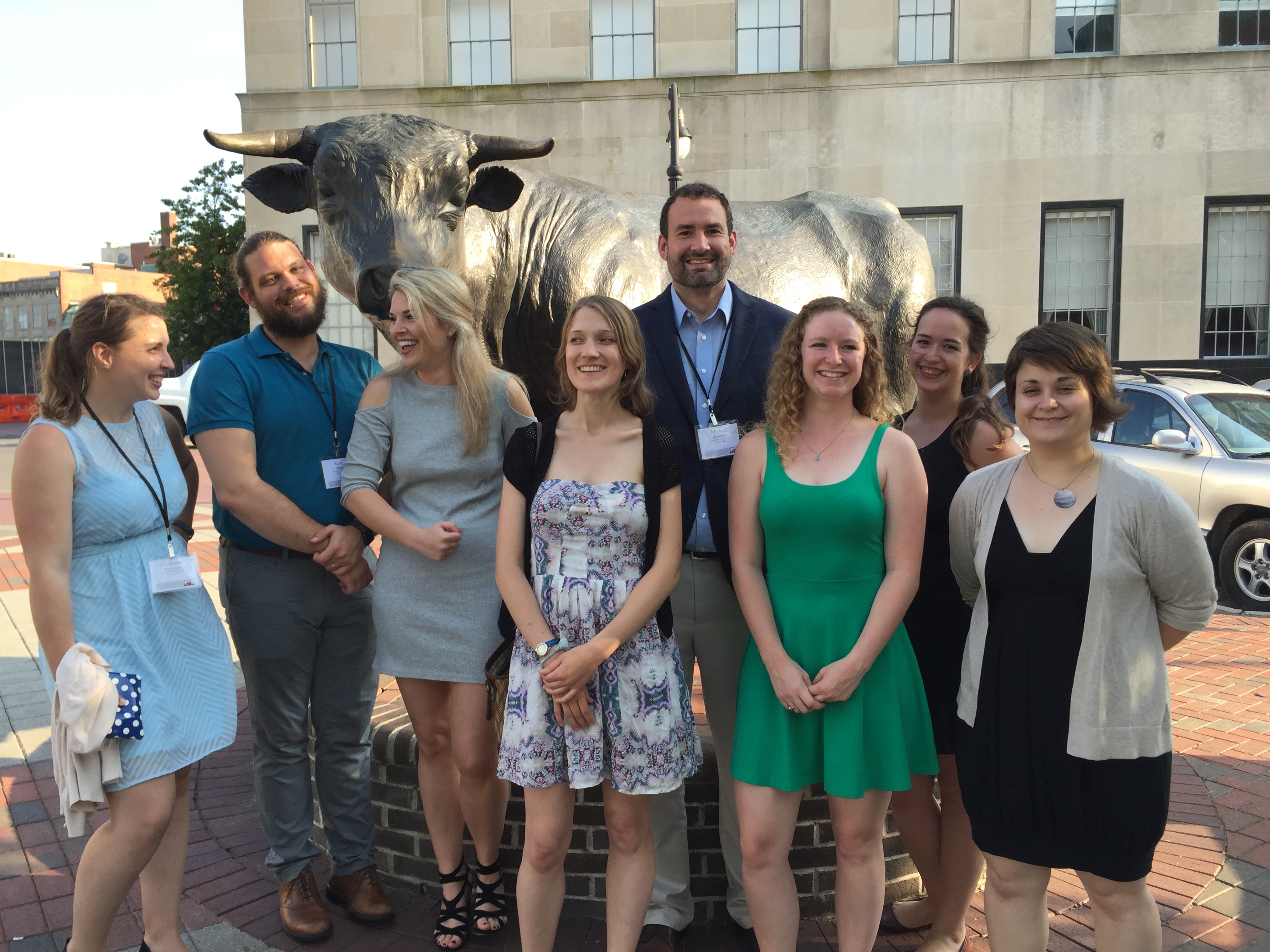
Seven University of Delaware graduate students attended the 2016 VAF conference in Durham, thanks to generous support from the VAF’s Ambassadors Award and the Center for Historic Architecture & Design (CHAD). Led by Dr. Rebecca Sheppard and Catherine Morrissey, the UD contingent represented four degree programs—including the MA in Historic Preservation (Kevin Barni, Emma Gencarelli, and Lauren Johnson), the PhD in Preservation Studies (Michael Emmons), the Winterthur Program in American Material Culture (Michelle Fitzgerald and Allie Ward), and the MA in Urban Affairs & Public Policy (Gemma Tierney).
After driving from Delaware to Durham on Wednesday, the group scattered to different tours on Thursday and Friday, frequently posting photos with the #vaf2016 to social media as a record of their experiences. Just as valuable to the students as the immersive lessons gained on some fabulous bus tours, were the connections made during the tours, the reception, coffee breaks, paper sessions, and serendipitous conversations in elevators and the hotel lobby.
The students wished to share some of their thoughts and experiences in their own words.
Michelle Fitzgerald and Allie Ward:
As students at Winterthur, attending VAF Durham was a wonderful chance for us to meet people in the field and learn about traditional architectural forms in situ. One of the highlights for us was listening to the paper presentations on Saturday. Hearing about current scholarship and field work was inspiring, especially the focus on African American history, structures, and craftsmen.
During our Piedmont Patchwork tour, we were excited to see the Quaker meetinghouses. They are a familiar architectural form to us, but seeing the buildings in the south developed a new context for understanding the importance of the building style. Comparing forms of Pennsylvania Quaker architecture with the similar Germanic style throughout North Carolina was a perfect introduction to comparative forms of typologies in the field.
Old Salem on Sunday was one of our favorite stops. While there, we experienced a true connection in styles between the Moravian architecture and furnishings. We had a chance to look at some Moravian furniture and were able to pick out distinctive construction styles that were similarly reflected in their architecture.
Gemma Tierney:
I came away from the conference in Durham with an appreciation of how thought-provoking this conference is for both students and professionals. I especially enjoyed the varied perspectives offered by those who interpreted the sites we toured--from members of the Pope family at the Captain John S. Pope Farm to new homeowners on Holloway Street, from docents in Milton to developers at the Golden Belt Manufacturing Company site. I had previously read articles by some of the academics attending the conference, so it was fascinating to meet them in person. Their more familiar research veins were complemented by the work of presenters only recently breaking into the field. Overall, my first time attending a VAF conference proved to be an enriching way to learn about the Durham area, and the work of historic preservationists across the country.
Kevin Barni:
My first VAF conference was full of new experiences for me. I attended as a Simpson Fellow, excited to present my research to an audience of like-minded professionals. I was pleasantly surprised at the support and help that I received related to my work. The fresh eyes on a topic that I was so entrenched in provided me with new ideas and approaches I had not considered.
I especially enjoyed posting images to social media during the tours. It made me really consider the sites in a way that would be compelling to viewers who were not there. That required me to find angles and aspects of the sites that would have gone unnoticed if I had not been approaching the site in this way.
Lauren Johnson:
VAF helped me to ask questions about a familiar place that I had never asked before. As a Southerner, I knew the landscape well and could tell you where the tobacco fields were, but now I realize why they are there and that while patterns, placement, and economy may grow familiar to some, understanding the landscape through a vernacular lens gives new life to sense of place and cultural identity. Another instance of encouragement occurred walking through a Durham neighborhood while discussing the “three bay vernacular” with a VAF veteran who laughed that he didn’t know what to call it either and that we’d need to go inside to see the floor plan.
Emma Gencarelli:
It was the casual discussions that really made Durham 2016 for me. Standing by to listen to an expert explain their thoughts about a vernacular building was a free lecture and a look into the way others see and then interpret in these building types. It was also nice to have them suggest that I would have something interesting to say as a recent graduate. Sitting with some of the familiar names from my own coursework, but instead talking about kayaking in the New Jersey Pine Barrens, or retiring to Maine, or clinking beer glasses while listening to an absolutely biblical thunderstorm pound on the roof were even more impactful meetings for me. It showed me that students, both still studying and recently graduated, were valued as colleagues.
Michael Emmons:
This was my third consecutive VAF, and probably the most rewarding yet. For starters, I was honored to participate in the experimental 'Field Notes' panel on new approaches to fieldwork. Later that evening, it was touching to see Catherine Bishir and Tom Carter recognized for their invaluable contributions to vernacular architecture studies. And, as usual, throughout the conference, I enjoyed reconnecting with familiar faces and encountering lots of new ones. I'm already looking forward to seeing everyone in Salt Lake City!
After a final tour of Old Salem on Sunday morning, the UD caravan headed north. The students left North Carolina re-energized for summer internships and new jobs, already planning how to attend next year’s conference in Salt Lake City. Thank you, VAF Ambassador Awards, for a wonderful experience!